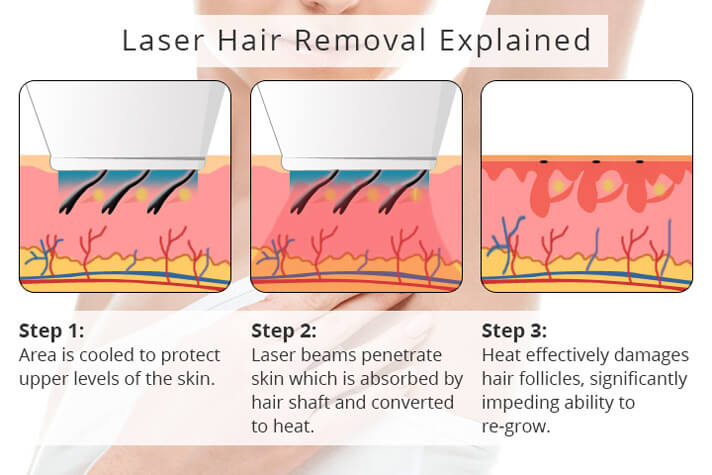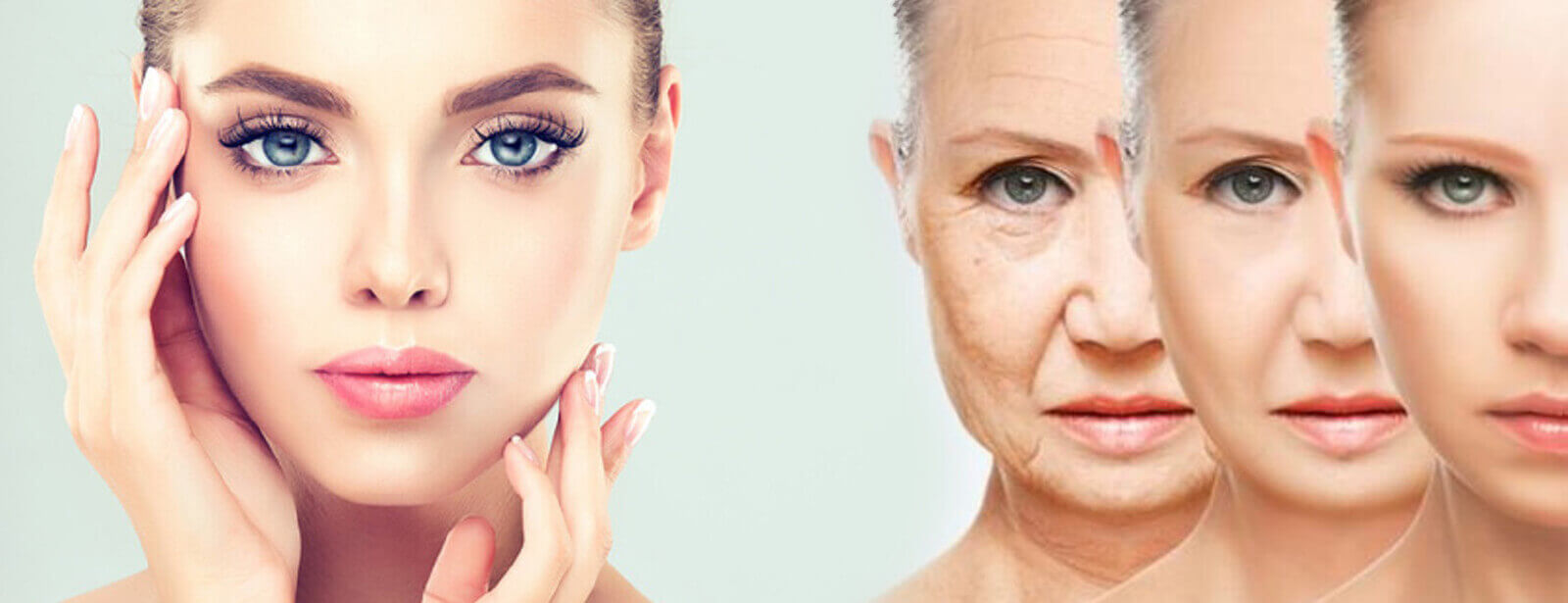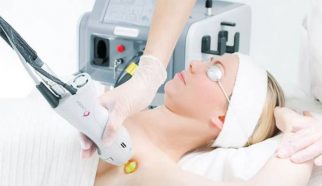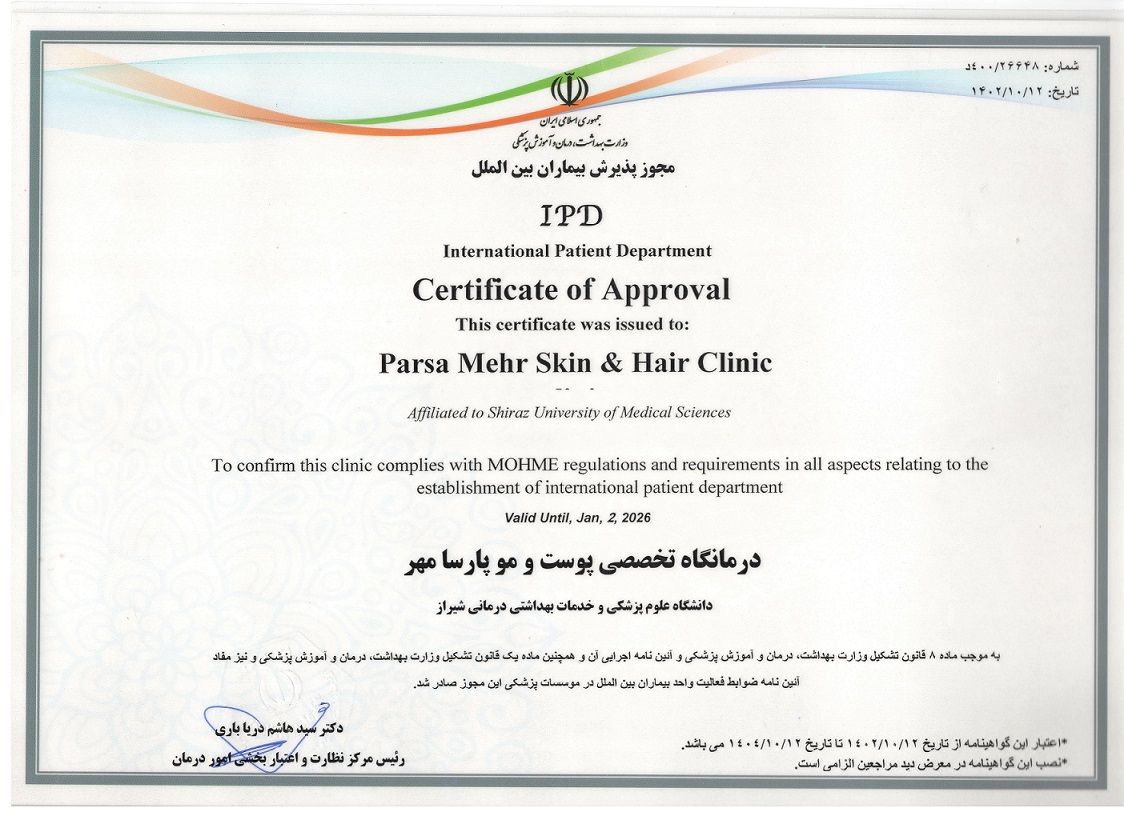
Many of us have heard about laser hair removal. Some consider it miraculous, some say it’s useless, and some are afraid of lasers and their side effects! Nonetheless, it’s laser, and it can cut through stone and iron! If you’re not very familiar with lasers, think it’s useless, have had an unpleasant experience before, or belong to those who fear the side effects of lasers, this article is for you. Here we’ve explored everything related to laser hair removal, stated the facts, and tried to provide useful clarification.
What is laser hair removal?
We don’t want to overwhelm you with scientific discussions about lasers, but it’s good to have a general idea of how lasers work and their effects.
A laser is a beam of light. However, it’s light that has special physical properties and is very high in energy. Lasers have various uses in medicine and industry. In industry, they’re used for cutting and engraving, and in medicine, lasers are used for various surgeries like eye surgery (LASIK).
Laser is a science and technology. It means depending on its application, specific properties can be considered, and it can be optimized to perform a particular task efficiently. Laser hair removal is precisely designed in a way that it removes excess hair without affecting other parts of the skin and body.
Different lasers are used for hair removal. Alexandrite, Nd:YAG, and diode technologies are among the most commonly used lasers for hair removal. These lasers differ in their applications. For example, Alexandrite is more effective for those with fair skin, and Nd:YAG is more commonly used for darker skin tones. This practical difference is due to the distinct physical properties of lasers such as frequency and wavelength.
The laser affects follicles. Laser hair removal is designed in a way that heats the hair bulb and damages the follicles. Follicles are small organs inside the skin that produce body hair. By damaging the follicle and hair bulb, hair growth is permanently stopped.
Laser introduces selective damage. An important point is that the heat from the laser damages and disables the follicles, but this damage is entirely selective. It means that no simultaneous damage occurs to the skin and tissues surrounding the follicle. However, sometimes due to operator error, the skin may experience damage. We’ve discussed these issues in the side effects of laser hair removal section.
Laser results in permanent reduction of excess hair. This method can permanently remove between 70% to 90% of excess hair. Therefore, scientifically speaking, laser results in permanent reduction of excess hair, not permanent removal. Because in one treatment session, we cannot remove 100% of excess hair. But the 70% to 90% that are removed will never grow back.
Applications of laser hair removal
Laser hair removal can be used on any part of the body. However, visits for laser treatment on some parts of the body are more common. For example, in women, laser for the bikini area and face is more common. In men, laser for underarms, beard lines, back, and neck is more common. However, the laser method is so flexible, fast, and effective that you can laser the entire body in less than an hour.
Regardless of how restricted or extensive the treatment area is (whether it’s just the upper lip or the entire body), to effectively remove or reduce excess hair, you must complete a treatment course. This course usually includes 4 to 6 laser sessions with intervals of about 6 weeks.
Laser hair removal for the face
The face is a sensitive area of the body where we can safely remove excess hair with lasers. However, eyebrow hair cannot be lasered because there is a risk of eye damage, but we can effectively remove hair between the eyebrows with lasers.
Given that shaving is not recommended for women, and plucking and waxing can increase the thickness and density of excess hair, laser hair removal is your best option.
Comparison with other methods
Laser is the best method for removing facial hair because shaving can leave permanent scars on your face and you have to shave your face every 3-4 days. Waxing, plucking, and threading can increase blood flow to the skin and lead to more hair growth. So the best way to permanently and safely remove unwanted facial hair is laser hair removal.
For women with polycystic ovary syndrome (PCOS)
Facial hair for women suffering from polycystic ovary syndrome (PCOS) or polycystic ovary syndrome (PCOS) is a fundamental problem. Facial hair in this condition becomes thick and abundant. Again, waxing, plucking, and shaving are not suitable solutions because they can cause thickening and increase in unwanted hair. Although laser hair removal is not as effective for women with polycystic ovary syndrome as it is for others, it can still significantly help reduce facial hair.
Number of sessions
Facial laser hair removal is done very quickly and may take 5 to 10 minutes, but facial hair (like hand hair) is very stubborn and requires more sessions. Typically, for effective removal of facial hair, you need 6 to 12 laser sessions with intervals of 2 to 4 weeks.
Pain of facial laser
The level of laser pain depends mostly on the area and your tolerance threshold. Generally, lasers in lower face areas, front of ears, and upper lip are not painful. Laser on the forehead may be slightly painful in the first sessions, but it decreases in subsequent sessions. For those who feel a lot of pain, we can use numbing creams or painkillers.
Risks and dangers of facial laser
The most important risk of laser hair removal in the facial area is the risk of eye damage. However, if we use appropriate protective equipment, the chance of eye damage is zero. You may see flashes of light during treatment. But don’t worry, these flashes do not harm your eyes.
Again, the most important preventive factor against laser side effects is avoiding direct sunlight. Leave tanning beds and sun exposure until after the completion of the entire laser treatment course. Whenever you go outside, use a high SPF sunscreen. Remember that the effect of sunscreen disappears after 2 hours, so you need to apply sunscreen again.
Best facial laser center
Women’s facial hair is usually thin. The thinner and lighter the hair, and the darker the skin, the harder it is to laser the hair. If you have thin or light hair or dark skin, you should go to a center equipped with at least Alexandrite and Nd:YAG lasers. Another point to consider about facial hair removal laser is skin cooling methods, which if not done properly, can damage the facial skin. So both the laser device and the operator’s skill in properly cooling are effective.
At the White House Clinic, we use three different laser technologies and the best devices available in the market. Our operators have years of experience in facial laser hair removal and know very well how to perform a painless and effective laser for you.
Underarm laser
Underarm hair removal is one of the most popular uses of laser. Laser in this area is very fast and painless and will be completely effective. For effective removal of underarm hair, you will need almost 5 sessions with intervals of about 5 weeks. After 5 sessions, we expect about 90 to 95 percent of the underarm hair to be permanently removed.
Pain of underarm laser
Underarm laser is painless for most of our clients. However, if you feel pain, we can use local anesthetics. Usually, the first session of underarm laser is more painful, and as mentioned, you will feel like a rubber band hitting your skin. You will feel less pain in subsequent sessions.
Risks and dangers
As always, there is a risk of cuts, burns, and pimples; but if your operator is skilled and experienced enough, the likelihood of these risks is very low, and in fact, close to zero.
Immediately after the laser session, you may feel a little redness, warmth, and swelling. If necessary, you will be given an ice pack to reduce inflammation. Sometimes, we prescribe corticosteroid creams (cortisone) to improve the swelling and inflammation of the area.
Best underarm laser center:
One of the simplest and least painful areas of the body for laser hair removal is the underarm; but again, it doesn’t mean it’s risk-free or without side effects. We still recommend that you thoroughly research the laser center you have in mind. Make sure you trust the operators’ skills and be sure to go to a center where laser is performed under the supervision of a physician.
Hair laser for men
Most of what we have said so far has been related to women. But all laser services provided to women are also available to men. In the past, almost all laser hair removal clients were women, but today this ratio has changed and evened out.
How does laser hair removal help men?
Laser does not necessarily smooth the skin. Some of our clients just want to reduce the density of their body hair. For example, they have a very hairy chest but don’t want to be completely hairless. Some men also want to completely remove hair from certain parts of their body, such as the hair on the back of their shoulders and neck. Whether your goal is to reduce density or completely remove unwanted hair, both can be done with laser hair removal.
Laser hair removal is ideal for male athletes. Laser can make the lives of footballers, cyclists, swimmers, and other athletes who need to constantly groom their body hair easier. No more cutting with a razor, no more post-shave pimples, and no more itching after hair grows back. You will be permanently rid of annoying hair.
The only way to treat ingrown hairs and folliculitis is laser. Ingrown hairs are small bumps that occur in many men after shaving, especially in the neck area. This common problem, known as pseudofolliculitis barbae, is completely eliminated with laser. Just one laser session can eliminate all ingrown hairs. Of course, to avoid this
problem again, you need to complete the laser treatment course.
Folliculitis refers to pimples caused by follicle inflammation. With the help of laser hair removal, we eliminate the follicle. When there is no follicle left, there is nothing to become inflamed and ultimately pimpled.
Pain, Risks, and Side Effects of Laser Hair Removal for Men
The level of pain depends on your pain threshold and the area being treated. The more sensitive the skin in the area, the more pain you may experience. Most men say that laser hair removal is not painful and only mildly uncomfortable at times. A small percentage describe the sensation as similar to a rubber band snapping against the skin. About 1-2% may experience more significant discomfort, for whom we can use topical numbing medications to reduce pain by half.
Risks of laser hair removal for excess hair are the same for both men and women. We still face risks of burns, wounds, changes in skin color, and folliculitis. However, when a treatment session is performed by an experienced and professional operator under the supervision of a specialized physician, the likelihood of laser risks approaches zero. Claims of cancer risk, damage to the reproductive system, and similar issues are unfounded.
Following post-laser recommendations (such as avoiding sunlight and refraining from exercise) significantly reduces the likelihood of side effects. Generally, permanent and serious side effects of laser are very rare and usually result from errors in laser treatment execution. Rare side effects that may occur include temporary changes in skin color or temporary pimples, which resolve quickly.
Dreadful Risks and Side Effects of Laser
“I’m scared of the terrible side effects of laser.” We hear this statement from some of our clients and audience. Many articles and images about dreadful laser side effects have been published on the internet. However, these side effects only occur when laser treatment is performed by an untrained individual or in clinics without medical supervision or with non-standard and low-quality devices. When laser hair removal is performed under standard conditions, there is no risk or dreadful side effect.
Below, we list some of the dreadful risks and side effects attributed to laser, emphasizing that none of these are more than rumors or occur due to operator error:
* Laser is not carcinogenic. Laser light rays only heat up the hair follicles and destroy them. Unlike ultraviolet rays or X-rays, which produce cancer-causing molecules such as free radicals due to their high energy, laser light is not ionizing. Therefore, it is not carcinogenic.
* Laser does not cause infertility. Both men and women who undergo laser in the bikini area are concerned about this issue. The depth of laser penetration into the skin is only a few millimeters and never reaches your reproductive organs such as the ovaries or testicles to cause damage.
* Laser does not harm the hymen. This rumor is very concerning for young girls. However, the reality is that laser never comes close to the hymen.
* Laser does not harm the eyes. You will be provided with special protective glasses during the laser session. For added assurance, a cloth may also be placed under the glasses. You may see flashes of light during laser treatment (especially when the operator is working on your face), but these flashes do not harm the eyes. However, if the operator makes a mistake and the laser directly hits your retina, there is a risk of damage. If you experience severe burning, redness, or intense discomfort after laser, be sure to visit an ophthalmologist for further evaluation.
* Laser does not cause varicose veins. As we mentioned, laser only penetrates a few millimeters into the skin and never reaches the skin’s blood vessels and veins to have any effect on them. Laser hair removal on the legs may make varicose veins more visible, but it definitely does not cause them.
Side Effects Due to Operator Error
The worst side effects of laser hair removal are those that occur due to operator error. Below, we mention some of these side effects:
* Skin spots: Hyperpigmentation or the formation of dark skin spots and hypopigmentation or the formation of light skin spots are among the side effects of laser. However, if the laser operator is experienced and professional, it is very unlikely that you will experience this side effect. Treating skin spots is difficult and may never be resolved in some patients.
* Burns: One of the common side effects of laser is burns. Sometimes, burns are considered a natural consequence and are very mild. Sometimes, they result from operator error and are very severe. Skin blistering may even occur. If you experience severe and acute burns during laser hair removal, be sure to visit a specialized physician. There is no need for specific treatment for mild burns. Exposing the skin to air is sufficient, and zinc oxide cream can be helpful.
Natural Side Effects of Laser
Some side effects are considered natural consequences of laser. Redness, swelling, and a feeling of warmth are among the side effects that may be observed after laser. Applying ice after laser is very effective in reducing these symptoms. Special creams may also be prescribed to reduce inflammation.
Other side effects include dryness and peeling of the skin, which are seen in rare cases. Another natural side effect of laser is thickening of thin and brittle hairs. Since the primary hairs have been removed, thin and brittle hairs have the opportunity to become thicker and longer. Annual maintenance laser sessions are scheduled for this purpose to eliminate newly grown hairs.
The final point regarding the side effects and risks of laser hair removal is that active skin problems such as acne, scars, freckles, moles, eczema, and other skin eruptions should not come into direct contact with laser. If you have a skin lesion, it is usually covered during laser treatment, and laser is performed on other areas. Open wounds, skin infections, and unhealed stitches should also not come into contact with laser.
Minimizing Risks and Side Effects
The first and most important step to minimize risks and side effects is to find a suitable laser center. Throughout the text, we have mentioned the features of a good laser center, and here we review them once again:
* Center operators must have sufficient knowledge and experience in working with laser devices.
* All laser services must be under the supervision of a specialized physician.
* The appropriate laser for your skin color should be used. For example, Alexandrite is not suitable for individuals with dark skin.
* The laser devices in the laser center must be new and up-to-date. Newer devices are usually more effective.
The second step is to follow post-laser care recommendations. Below, we list some of them for you:
* Avoid direct sunlight after laser. Apply sunscreen when going outside, and reapply your sunscreen every 2 hours. Also, refrain from sunbathing, using tanning beds, or using tanning creams until your next laser session.
* Do not apply makeup for at least 12 hours after laser. If you really need to wear makeup, you can use very light powders 6 hours after laser.
* Avoid using other hair removal methods such as waxing or plucking for at least 2 days after laser.
* Refrain from physical activities, hot baths, jacuzzi, and sauna for at least 2 days after laser.
* Avoid using scrubs and similar products for at least 3 days after laser.
Effectiveness of Laser Hair Removal and Number of Sessions
Laser is the only permanent method for removing unwanted hair. The effectiveness of laser hair removal depends on the device used, skin color, hair thickness, and density of your unwanted hair. These factors are assessed in the first session, and the most suitable device for your skin as well as the number of sessions required for hair removal will be determined. To better understand the effectiveness of laser hair removal and have realistic expectations from this treatment method, examples are provided in the table below. Note that the numbers mentioned may vary for you.
As you can see, the reduction in hair depends on the number of sessions and the device used. For example, if the number of sessions with the alexandrite laser increases from 3 to 4, it can remove up to 30% more hair.
How Effective is Laser Hair Removal?
Laser hair removal is the only way to permanently remove unwanted hair. If laser is performed correctly, using appropriate devices and treatment protocols, it has permanent and remarkable effects. However, it’s important to note that laser cannot remove all unwanted hair, and 10 to 40 percent of the hair may remain after completing the treatment course.
So, in summary, the effects of laser are such that…
– 60 to 90 percent of unwanted hair is permanently removed.
– 10 to 40 percent of unwanted hair remains.
These statements apply to most applicants. There are factors that affect the final results of laser, which we’ll discuss a bit further. But before that, let us explain why 10 to 40 percent of unwanted hair may remain after completing the treatment course.
Why Can’t 100 Percent of Unwanted Hair Be Removed?
Follicles must go through three phases to produce each hair strand. Throughout these phases, a follicle creates and then sheds a hair strand multiple times during its lifetime.
The three phases of the hair growth cycle are:
– Anagen (Growth) Phase: 80 to 90 percent of unwanted hair is in this phase. A follicle in the anagen phase is actively producing a hair strand, which is growing.
– Catagen (Transitional) Phase: Hair growth stops, and the connection between the hair bulb and the follicle is severed during this phase.
– Telogen (Resting) Phase: 10 to 20 percent of unwanted hair is in this phase. A follicle in the telogen phase does not produce hair.
Laser hair removal is effective only on hair strands that are in the growth phase. Since not all hair is in the growth phase at any given time, laser cannot eliminate all of them. To improve this situation, long treatment courses and longer intervals between sessions are used. This way, more unwanted hair can be removed.
There are other factors that prevent the removal of all unwanted hair. For example, hormonal changes during pregnancy or after menopause can activate some follicles that we have deactivated with laser. Some body follicles produce different types of hair strands, such as lighter, white, thin, and curly hair. Laser is ineffective on these follicles. These follicles may produce thick and dark hair in the future.
Overall, considering all variables, we can predict that between 60 and 90 percent of unwanted body hair will be removed during a laser treatment course. In other words, laser causes permanent reduction in unwanted hair, not permanent removal.




